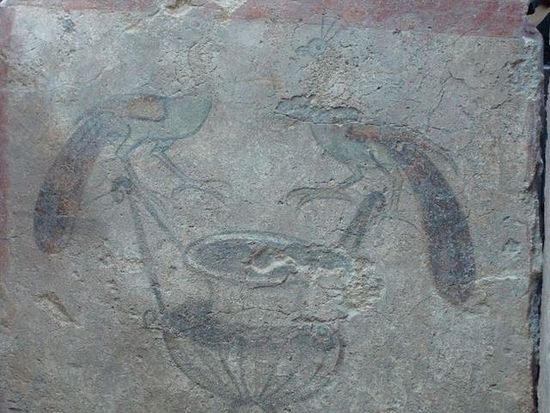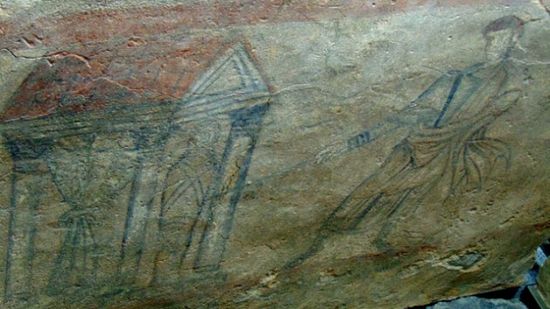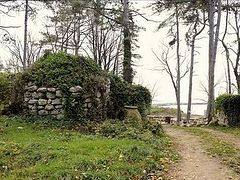Source: Archaeology in Bulgaria
October 6, 2015
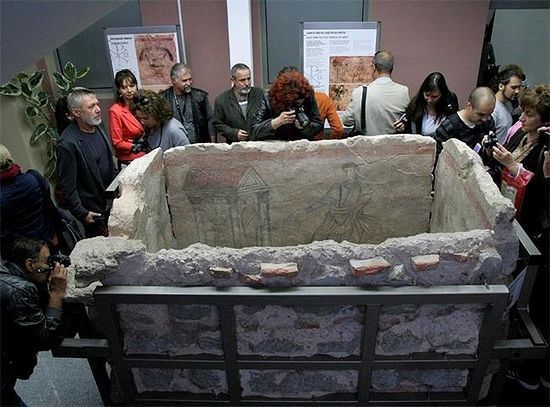 The 4th century AD Late Roman Early Christian tomb discovered in Bulgaria’s Plovdiv in 2012 has been restored and shown to the public for the first by the Plovdiv Museum of Archaeology. Photo: 24 Chasa daily
The 4th century AD Late Roman Early Christian tomb discovered in Bulgaria’s Plovdiv in 2012 has been restored and shown to the public for the first by the Plovdiv Museum of Archaeology. Photo: 24 Chasa daily
A 4th century AD Early Christian Roman tomb with stunning biblical murals depicting the miracles of Jesus Christ, which was found by accident in the southern Bulgarian city of Plovdiv in 2012, has now been restored and shown to the public for the first time.
The Early Christian Roman tomb whose inside shows two of the miracles of Christ, the Resurrection of Lazarus and the Healing of the Paralyzed Man, has been formally presented as part of the collection of the Plovdiv Museum of Archaeology.
It was found by construction works of the local power utility EVN behind the building of the former Communist Party headquarters in Plovdiv back in 2012, after which it was extracted by the localarchaeologists.
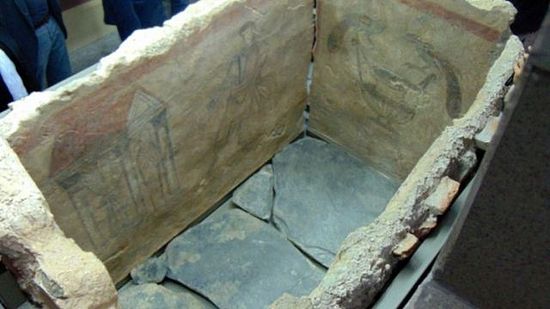 A view from above of the Early Christian Late Roman tomb with murals from Bulgaria’s Plovdiv. Photo: BGNES
A view from above of the Early Christian Late Roman tomb with murals from Bulgaria’s Plovdiv. Photo: BGNES
The rescue excavations of the tomb was extremely tricky because the artifact was located next to a gas pipeline, water supply and sewerage pipes, and a downtown street.
The Early Christian tomb from 4th century AD Philipopolis, as today’s Bulgarian city of Plovdiv was known in the Antiquity (it was named after one of the powerful rulers of the ancient world, King Philip II of Macedon) has been presented by the Director of the Plovdiv Museum of Archaeology Kostadin Kisyov, Plovdiv Mayor Ivan Totev, archaeologists, restorers, and representatives of the local power utility EVN, reports local news site Plovdiv24.
“The restored tomb is a monument of Early Christian art that any world-class museum would be happy to have,” archaeologist Maya Martinova, who was in charge of the excavations of the tomb after its accidental discovery, is quoted as saying.
Martinova has explained that the unique murals on the inside of the tomb were painted using the “wet fresco” technique (also known as “true fresco”), a highly durable technique where the wall is plasteredand painted at the same time, with the paint actually consisting of thick colored lime or chalk/plaster.
The archaeologists have concluded that the Early Christian Late Roman tomb was part of the southern necropolis of Philipopolis, the richest necropolis in Plovdiv (which according to one ranking is the oldest city in Europe, and one of the 10 oldest cities in the world).
The tomb was extracted and restored in two stages – first came the underground stage when the tomb was carefully excavated; the second stage was the conservation and restoration performed by the team of restorer Nikolay Sirakov, which took about 18 months.
The first stage was funded by the EVN power utility, while the second was sponsored by Plovdiv Municipality.
It is thanks to its murals, however, that the fully preserved 4th century AD Christian tomb in Bulgaria’s Plovdiv has been seen as a truly unique artifact.
“If we are talking about “uniqueness” – even though this word has become a cliché – the newly found tombis unique precisely because of its murals which are connected with the Early Christianity in Philipopolis,” says Assoc. Prof. Kisyov, the Director of the Plovdiv Museum of Archaeology, as quoted by the 24 Chasa daily.
“It is a very rare occurrence for an entire tomb to be exhibited in its authentic appearance with itsmurals,” he adds.
The tomb is 2 meters long and 1 meter wide, and is the only Early Christian tomb of this kind to have been found in Bulgaria so far.
The archaeologists believe it was the family tomb of a rich family living in Philipopolis in the Late Roman and Late Antiquity period, at the time of Early Christianity.
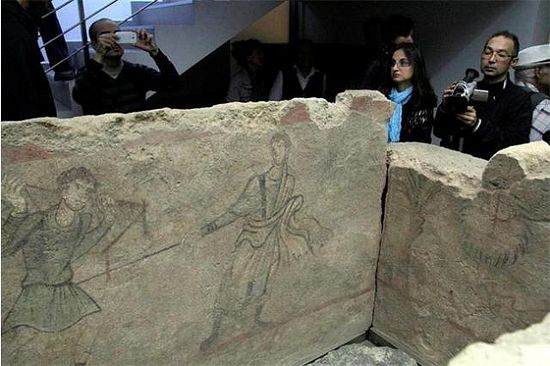 Another one of the murals on the inside of the 4th century AD Roman town shows another biblical scene in which Jesus Christ (right) heals the paralyzed man. Photo: 24 Chasa daily
Another one of the murals on the inside of the 4th century AD Roman town shows another biblical scene in which Jesus Christ (right) heals the paralyzed man. Photo: 24 Chasa daily
 One of the murals on the inside of the Early Christian tomb depicting the biblical scene of Jesus Christ (right) resurrecting Lazarus. This is said to be the world’s earliest known depiction of this scene. Photo: 24 Chasa daily
One of the murals on the inside of the Early Christian tomb depicting the biblical scene of Jesus Christ (right) resurrecting Lazarus. This is said to be the world’s earliest known depiction of this scene. Photo: 24 Chasa daily
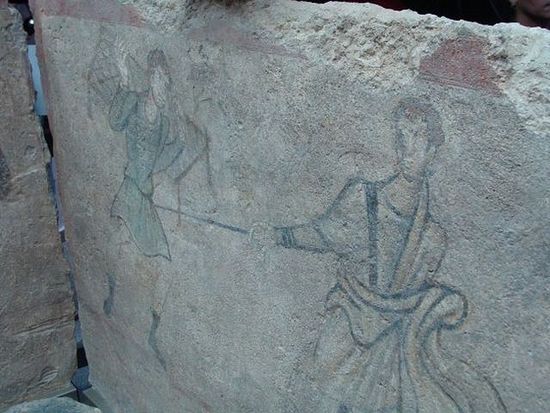 The same mural of Jesus Christ (right) healing the paralyzed man seen from another angle. Photo: Plovdiv24
The same mural of Jesus Christ (right) healing the paralyzed man seen from another angle. Photo: Plovdiv24
The inside of one of the long sides of the tomb in Bulgaria’s Plovdiv features one of the most excitingbiblical scenes, the Resurrection of Lazarus by Christ.
The opposite site shows another of the miracles of Christ, the scene in which Jesus Heals the Paralyzed Man.
The images of Christ in the 4th century AD tomb in Plovdiv show him as a young man with no beard or aureole (halo). It is the earliest image of Jesus Christ to have ever been found in Bulgaria.
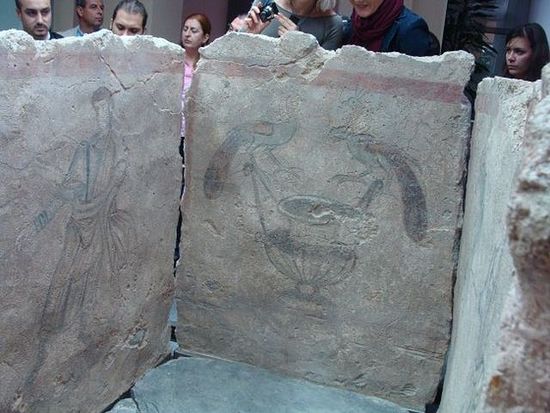 Another mural inside the Early Christian tomb shows a kantharos (cantharus) with two peacocks – one more Early Christian symbol. Photos: Plovdiv24
Another mural inside the Early Christian tomb shows a kantharos (cantharus) with two peacocks – one more Early Christian symbol. Photos: Plovdiv24
The shorter sides also feature Early Christian symbols. One of them shows two peacocks with akantharos (cantharus), an ancient deep bowl with two handles.
According to the experts, the image of the kantharos with the peacocks symbolizes the source of life and/or faith in resurrection and eternal life in Christianity. A similar depiction can be seen in one ofPlovdiv’s Early Christian basilicas.
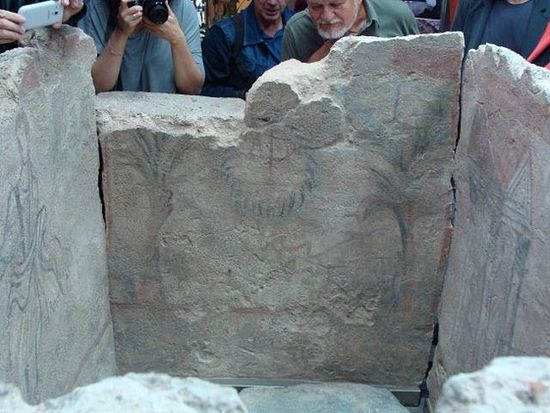 The last mural from the inside of the tomb features an image of a christogram inside a wreath shown together with the Greek letters of alpha and omega between two palm trees. Photo: Plovdiv24
The last mural from the inside of the tomb features an image of a christogram inside a wreath shown together with the Greek letters of alpha and omega between two palm trees. Photo: Plovdiv24
The other side depicts a christogram (a Christian symbol consisting of a monogram of letters standing for the name of Jesus Christ) shown between two palm trees together with the Ancient Greek letters alpha and omega which stand for the word of God.
Archaeologist Maya Martinova points out that the tomb’s mural depicting the Resurrection of Lazarusis the world’s oldest known depiction of this particular biblical scene. She adds that a similar depiction of the same scene can be seen in the catacombs of Rome.
Martinova also says that the murals of the tomb – which are painted with black, white, red, green, and ochre – show a style of painting that is on the border between paganism and Early Christianity.
She summarizes the meaning of the murals in the 4th century AD Roman tomb as being “saturated” with the concept of immortality and resurrection, which is a central idea in Christianity.
Museum Director Kostadin Kisyov has made it clear that the newly restored Early Christian tomb will become one of the main attractions of the Plovdiv Museum of Archaeology which already has an extremely rich collection.
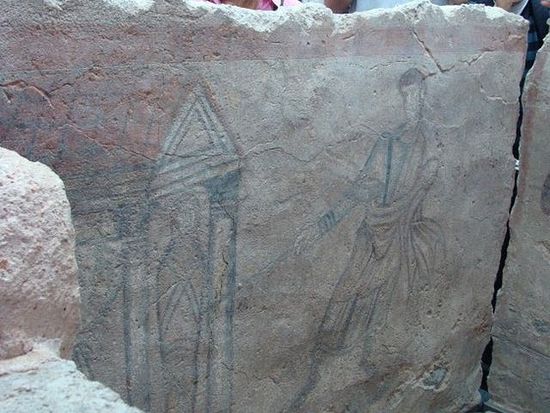 Another view of the probably the most interesting of the four murals inside the Early Christian tomb in Bulgaria’s Plovdiv – the Resurrection of Lazarus by Christ. Photo: Plovdiv24
Another view of the probably the most interesting of the four murals inside the Early Christian tomb in Bulgaria’s Plovdiv – the Resurrection of Lazarus by Christ. Photo: Plovdiv24
Background Infonotes:
The history of the southern Bulgarian city of Plovdiv – often dubbed the oldest city in Europe – began with the human settlement on the ancient hill of Nebet Tepe (“tepe” is the Turkish word for “hill”) is one of the seven historic hills where today’s Bulgarian city of Plovdiv was founded and developed inprehistoric and ancient times. The hills, or “tepeta”, are still known today by their Turkish names from the Ottoman period. Out of all of them, Nebet Tepe has the earliest traces of civilized life dating back to the 6th millennium BC, which makes Plovdiv 8,000 years old, and allegedly the oldest city in Europe. Around 1200 BC, the prehistoric settlement on Nebet Tepe was transformed into the Ancient Thracian city of Eumolpia, also known as Pulpudeva, inhabited by the powerful Ancient Thracian tribe Bessi. During the Early Antiquity period Eumolpia / Pulpudeva grew to encompass the two nearby hills (Dzhambaz Tepe and Taxim Tepe known together with Nebet Tepe as “The Three Hills”) as well, with the oldest settlement on Nebet Tepe becoming the citadel of the city acropolis.
In 342 BC, the Thracian city of Eumolpia / Pulpudeva was conquered by King Philip II of Macedonrenaming the city to Philippopolis. Philippopolis developed further as a major urban center during theHellenistic period after the collapse of Alexander the Great’s Empire. In the 1st century AD, more precisely in 46 AD, Ancient Thrace was annexed by the Roman Empire making Philippopolis the major city in the Ancient Roman province of Thrace. This is the period when the city expanded further into the plain around The Three Hills. Because of the large scale public construction works during the period of Ancient Rome’s Flavian Dynasty (69-96 AD, including Emperor Vespasian (r. 69-79 AD), Emperor Titus (r. 79-81 AD), Emperor Domitian (r. 81-96 AD)), Plovdiv was also known as Flavia Philippopolis.
Later emerging as a major Early Byzantine city, Plovdiv was conquered for the First Bulgarian Empire(632/680 – 1018 AD) by Khan (or Kanas) Krum (r. 803-814 AD) in 812 AD but was permanently incorporated into Bulgaria under Khan (or Kanas) Malamir (r. 831-836 AD) in 834 AD. In Old Bulgarian (also known today as Church Slavonic), the city’s name was recorded as Papaldin, Paldin, and Pladin, and later Plavdiv from which today’s name Plovdiv originated. The Nebet Tepe fortress continued to be an important part of the city’s fortifications until the 14th century when the Second Bulgarian Empire (1185-1396 AD) was conquered by the Ottoman Turks. During the period the Ottoman yoke(1396-1878/1912) when Bulgaria was part of the Ottoman Empire, Plovdiv was called Filibe in Turkish.
Today the prehistoric, ancient, and medieval settlement on Nebet Tepe has been recognized as theNebet Tepe Archaeological Preserve. Some of the unique archaeological finds from Nebet Tepe include an ancient secret tunnel which, according to legends, was used by Apostle Paul (even though it has been dated to the reign of Byzantine Emperor Justinian I the Great (r. 527-565 AD)) and large scalewater storage reservoirs used during sieges, one of them with an impressive volume of 300,000 liters. Still preserved today are parts of the western fortress wall with a rectangular tower from the Antiquity period.

